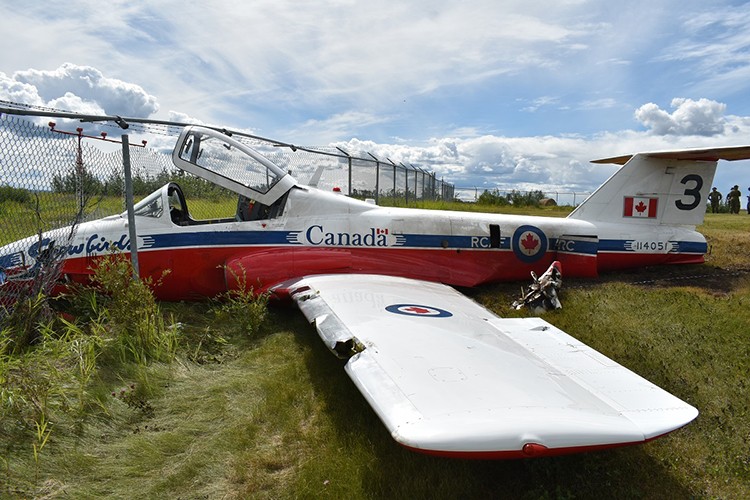Estimated reading time 6 minutes, 27 seconds.
The operational pause ordered on the CT-114 Tutor fleet operated by the Canadian Forces Snowbirds (431 Air Demonstration Squadron) has been lifted, effective as of Sept. 20.
The pause was ordered by the commander of 1 Canadian Air Division, MGen Iain Huddleston, on Aug. 8, following an accident on Aug. 2 involving one of the nine Tutor jets that were stationed in Fort St. John, British Columbia, for an airshow. The RCAF’s Directorate of Flight Safety launched an investigation to determine the cause of the accident, and whether it posed any risk to continued flying operations.

“Thanks to the thoroughness of our investigative processes, we have been able to conduct a complete risk analysis that has shown it is safe for the CT-114 Tutor fleet to resume flying,” said Huddleston.
The initial From the Investigator report from the Directorate of Flight Safety has now been released, confirming that the Tutor jet involved in the accident experienced an engine failure, which was due to “an improperly assembled oil filter.” The investigation will continue to “analyze the human factors that may have contributed to this occurrence,” a Department of National Defence (DND) press release states.
According to the investigation report, the team had performed at the Fort St. John International Air Show on July 30 to 31, and the accident occurred two days later, when the aircraft involved was set to be ferried back to Moose Jaw, Saskatchewan, on a standard IFR transit flight.
The report confirms that the pilot, who was the sole occupant of the aircraft, conducted a routine series of pre-flight checks before departure.
“Shortly after liftoff, the pilot confirmed a positive rate of climb and selected the landing gear up,” the report reads. “Immediately after gear selection, the pilot heard a loud noise and the engine failed. The aircraft rapidly started decelerating and descending back to the runway.

“The pilot selected the landing gear back down and elected to land the aircraft straight ahead, however the landing gear did not have sufficient time to fully cycle back to the locked-down position. The aircraft touched down with only approximately 500 feet of runway remaining. The unlocked landing gear collapsed under the weight of the aircraft, and the aircraft skidded off the departure‑end.”
The Tutor jet traveled roughly 1,000 feet after landing, impacting the airport perimeter fence “at low speed” before stopping. The pilot, who did not sustain any injuries, secured the engine and exited the aircraft immediately.
Now that the operational pause on the CT-114 Tutor fleet has been lifted, the DND confirmed that the Snowbirds will resume flying at their home base at 15 Wing Moose Jaw this week. The Tutor jets that are currently still in Penticton and Fort St. John will return to 15 Wing next week.
However, given that it is now so late in the 2022 airshow season, and the team has not flown since Aug. 2, “there is not enough time left for them to conduct the number of practices necessary to return to form for their scheduled shows,” the DND said.
As such, the team’s remaining scheduled performances for this year have been canceled.
There were four locations left on the Snowbirds’ 2022 schedule between Sept. 24 and Oct. 16, including Mirabel, Quebec, and Huntington Beach, Salinas, and Santa Maria in California.
In total, the team has had to cancel 14 performances this year.

“While we are happy that we can safely resume flying, we are very disappointed that our season ended so early,” said LCol Denis Bandet, commanding officer of the Snowbirds. “Our focus now is to get back in the air, get our jets home, and start working on preparations for next year’s show season.”
Huddleston added: “The decision to cancel [the Snowbirds’] remaining performances was a difficult one. Looking forward, we will provide the [team] with the support they need as they build towards their 2023 show season.”









Lately, I have wondered if the tutor jet aircraft is getting long in the tooth and should be replaced. Engine reliability is everything in that game.
Park them all, nothing more than an embarrassment.
a improper installed oil filter isn’t the jets design fault
Any engine will fail if improperly majntained
A new aircraft would have done the exact same thing, this crash had nothing to do with the age of the CT114.
The initial From the Investigator report from the Directorate of Flight Safety has now been released, confirming that the Tutor jet involved in the accident experienced an engine failure, which was due to “an improperly assembled oil filter.” The investigation will continue to “analyze the human factors that may have contributed to this occurrence,” a Department of National Defence (DND) press release states.
Fram from Canadian Tire?
Park all the museum planes and get new up to date planes, these are nothing but a joke. They waiting for more pilots to die?
They talk in the report about a leak check prior to the flight. This step would be key to ensuring the aircraft was serviceable prior to take off. I would be very surprised if a proper leak check was accomplished. The engine filter that was improperly installed must have leaked a massive amount of engine oil very quickly for the engine to fail during the take-off run. This would likely have been picked up during a proper leak check. I would look towards complacency as the 1st human factor to explore. Nothing to do with the aircraft just the humans involved which is the case +80% of the time.